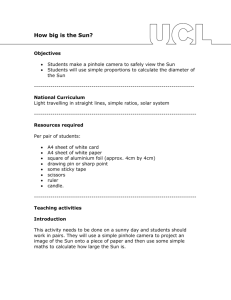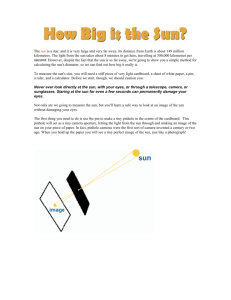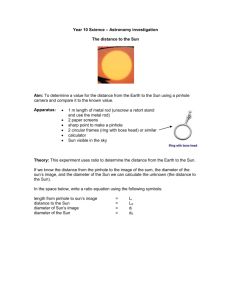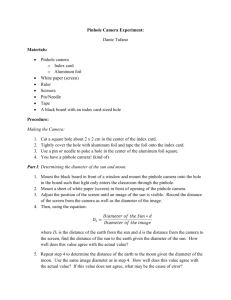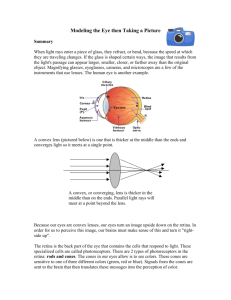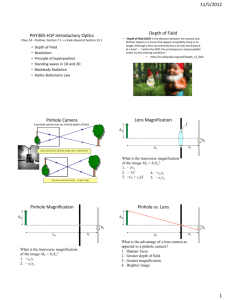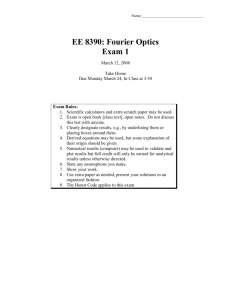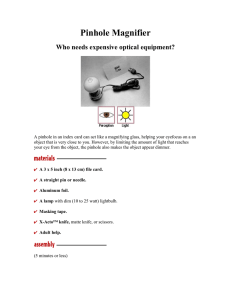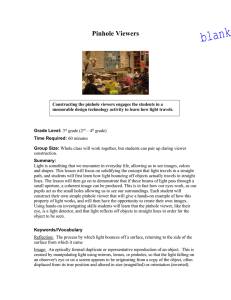Document 10519605
advertisement
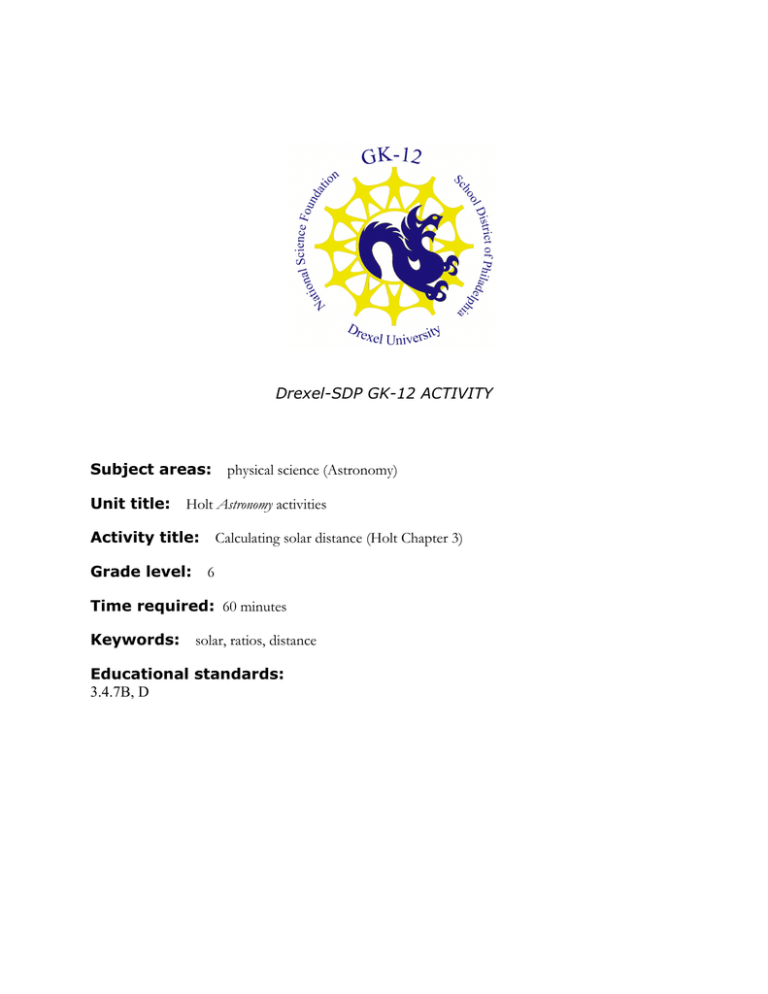
Drexel-SDP GK-12 ACTIVITY Subject areas: Unit title: physical science (Astronomy) Holt Astronomy activities Activity title: Grade level: Calculating solar distance (Holt Chapter 3) 6 Time required: 60 minutes Keywords: solar, ratios, distance Educational standards: 3.4.7B, D Concept/Vocabulary In this activity, students investigate the diameter of the sun, using a self-constructed measurement device. Students will become familiar with the idea of projected images, and that visual representations of objects have a particular scale. They will also use the Holt text and other resources to review the following solar-related terms: • nuclear fusion • sunspot • gravity • Kelvin Students will exercise concepts of fractions, scaling and ratios, statistics, formulas, and dimensions, . They will practice measurement skills using rulers or tape measures. Objectives • Students will understand how a projected light image can be larger, smaller, or equal in size to the actual image. • Students will understand how ratio techniques can be used to determine an unknown quantity (in this case, the diameter of the sun). INSTRUCTIONAL STRATEGIES Group size: This activity can be performed in groups of 4-6 students. Duration: It can be performed in one class period. BEFORE • As a preparatory homework assignment, students should research the distance of the earth from the sun. This information will be used to calculate the diameter of the sun in the experiment. DURING • Students will be constructing a pinhole viewer for astronomy projections. Each student or student group should be given a flat piece of cardboard. This will be used as the frame for their pinhole viewer. • Students should measure and cut a 2 cm x 2 cm square in the middle of the cardboard. • Students should measure and cut a 3 cm x 3 cm piece of aluminum foil. This foil should be taped over the hole, so the hole is completely covered. • Using a pushpin, instruct students to carefully make a small hole in the foil. • Set the pinhole viewer about 4 inches from a small light source. The room should be darkened for best effect. • Holding a white sheet of paper a few centimeters from the pinhole viewer, observe the projected image of the light source. Have the students comment on the effect of moving the paper closer and further from the pinhole viewer (they should observe the image getting smaller and larger). Students should understand that it is possible to make an image that is smaller than the light bulb, equal in size to the light bulb, and larger than the light bulb. Draw a connection between the simple pinhole viewer the students have constructed and a camera. Both allow light to pass through a small aperture. In a camera, this light would be focused with lenses, and would be projected onto either chemically reactive substance (in a film camera) or a electronic component that measure light intensity and color (in a digital camera). • Students will next attempt to project an image of the sun onto the paper. This should be done on a brightly sunny day. Students should be reminded to not look directly at the sun. In order to successfully see an image of the sun on the paper, it may be necessary to darken the paper by shading it. • Instruct students to trace the projection of the sun on the paper with a pencil. Another member of the group will measure the distance between the paper and the pinhole viewer. • Students groups will now use a ratio technique to calculate the diameter of the sun. They will need to know their research information on the distance of the earth from the sun (93,000,000 miles or 149,600,000 kilometers). The students will use the equation: AFTER Math Connection • Students can perform the graphing exercise listed in the Connection Activity on page 69 of Astronomy Teacher Edition. • Have different groups compare their answers with one another. There will likely be variation between in the answers calculated by different groups. The class should calculate the average mean diameter for the whole class (optional extension calculations would be mode, standard deviation, etc.). • Compare the average class answer with the accepted answer (870,000 miles or 1,400,000 kilometers). Discuss possible reasons why the class experiment answer might be different from the accepted answer “from literature.” • Using the assumption that geometry of the sun is a perfect sphere, invite the students to research an equation that will allow them to use their measured diameters to calculate the volume of the sun. (Students will need to use the discover that ½ diameter = radius, and that spherical volume 4 is calculated with the equation π r 3 . 3 Reading/Writing Students will write a concise summary of the experiment in their science notebooks, focusing on a simple hypothesis, method of testing, and results. They should be encouraged to briefly explore any of their ideas that may have changed during and after the experiment. Extended Learning Opportunity Students may research the Greek astronomer, Aristarchus, who first tried measuring the distance to the sun. Students should describe Aristarchus’ technique, and should discuss how accurate his calculations were. Keywords Sun, light, scale, ratio Author Matthew D. Cathell Review Question Q: How does energy produced by nuclear fusion move from the sun’s core to space? A: It moves very slowly through the radiative zone, circulates through the convective zone, passes through the photosphere, and leaves the sun as light. PSSA What provides the best evidence that light is a form of energy? A. light reflects from a smooth surface B. light raises the temperature of an object it strikes* C. light travels in a straight line until it strikes an object D. light diffracts when it passes through a narrow opening This activity was adapted from The Center for Space Education http://cse.ssl.berkeley.edu/AtHomeAstronomy/activity_03.html Owner: Drexel University GK-12 program, Engineering as a Contextual Vehicle for Science and Mathematics Education, supported in part by National Science Foundation Award No. DGE-0538476 Author: Matthew D. Cathell Copyright: Copyright 2007 by Matthew D. Cathell
